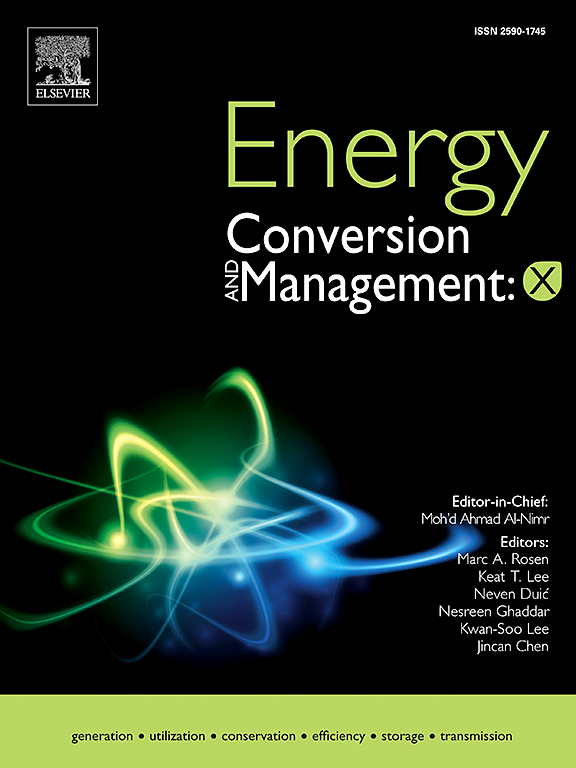Experimental investigation of a solid desiccant system with the staged adsorption/desorption process
IF 10.9
1区 工程技术
Q1 ENERGY & FUELS
引用次数: 0
Abstract
The staged solid-desiccant dehumidification system (SSDD), recently proposed to approach the thermodynamic efficiency limits of cyclic adsorption and desorption, has received little experimental scrutiny. We built and tested a pilot-scale SSDD comprising two fixed beds arranged in series (coated with SAPO-34 and EMM-8) and benchmarked it against a conventional silica gel system over various conditions. The dehumidification and regeneration processes were investigated separately. The SSDD delivered markedly superior dehumidification performance and exploited regenerative heat in a cascade fashion. Over the dehumidification runs, the SSDD achieved a maximum cumulative moisture removal advantage of 18.5 g. By contrast, silica gel displayed only a short-lived edge — confined to the first minute of every test, and its cumulative moisture removal never exceeded the SSDD by more than 2.04 g before being steadily overtaken. A distinctive ”M-shaped” instantaneous moisture removal profile in the SAPO-34 bed verified the predicted rapid adsorption phase driven by cooperative uptake. Regeneration tests confirmed a critical regeneration temperature of 90 110 °C, above which cascade utilization of regeneration heat enabled rapid desorption in both beds. These findings validated the two key advantage mechanisms of staged adsorption/desorption – (i) a sustained mass-transfer driving force and (ii) cascade energy utilization – and highlighted the SSDD’s potential as a high-efficiency solution for solid-desiccant dehumidification.
固体干燥剂分级吸附/脱附系统的实验研究
分级固体干燥剂除湿系统(SSDD),最近被提出接近循环吸附和解吸的热力学效率极限,很少得到实验审查。我们建立并测试了一个中试规模的SSDD,包括两个串联的固定床(涂有SAPO-34和EMM-8),并在各种条件下与传统硅胶系统进行了基准测试。分别对除湿和再生工艺进行了研究。SSDD提供了显著优越的除湿性能,并以级联方式利用再生热量。在除湿运行过程中,SSDD实现了18.5 g的最大累积除湿优势。相比之下,硅胶只显示了一个短暂的优势-仅限于每次测试的第一分钟,其累计除湿量从未超过SSDD超过2.04 g,然后逐渐被超越。SAPO-34床层中独特的“m型”瞬时除湿剖面验证了预测的由协同吸收驱动的快速吸附相。再生测试证实了90 ~ 110°C的临界再生温度,高于该温度的级联利用再生热使两个床层中的快速解吸成为可能。这些发现验证了阶段吸附/解吸的两个关键优势机制——(i)持续的传质驱动力和(ii)级联能量利用——并强调了SSDD作为固体干燥剂除湿高效解决方案的潜力。
本文章由计算机程序翻译,如有差异,请以英文原文为准。
求助全文
约1分钟内获得全文
求助全文
来源期刊

Energy Conversion and Management
工程技术-力学
CiteScore
19.00
自引率
11.50%
发文量
1304
审稿时长
17 days
期刊介绍:
The journal Energy Conversion and Management provides a forum for publishing original contributions and comprehensive technical review articles of interdisciplinary and original research on all important energy topics.
The topics considered include energy generation, utilization, conversion, storage, transmission, conservation, management and sustainability. These topics typically involve various types of energy such as mechanical, thermal, nuclear, chemical, electromagnetic, magnetic and electric. These energy types cover all known energy resources, including renewable resources (e.g., solar, bio, hydro, wind, geothermal and ocean energy), fossil fuels and nuclear resources.
 求助内容:
求助内容: 应助结果提醒方式:
应助结果提醒方式:


